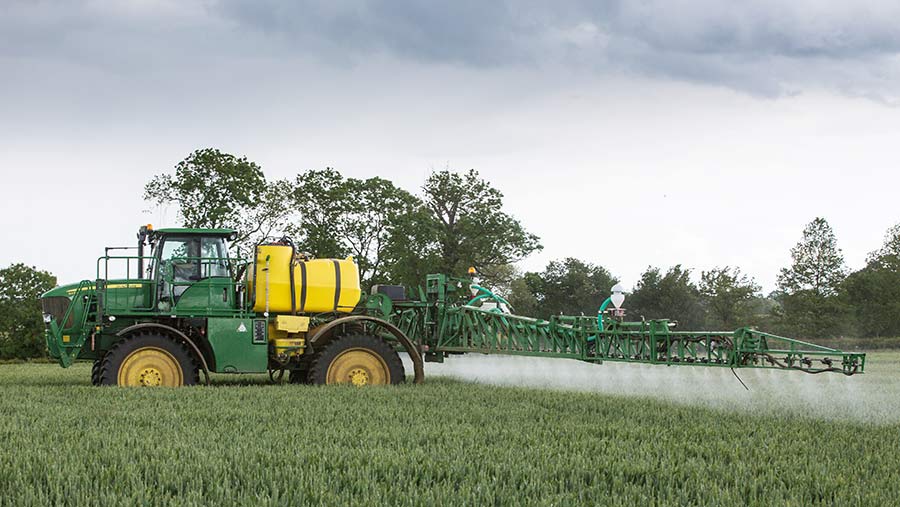Crop Watch: Forecast rain fuels fusarium risk in wheat
 © Tim Scrivener
© Tim Scrivener With ears now emerging (or about to) in winter wheat crops, agronomists are weighing up their options for the T3 ear spray.
An unsettled forecast for this week will increase the risk of ear diseases.
Ear emergence also means crops are being monitored for orange wheat blossom midge.
Finally, there is also a focus on weed control, with more wild oats being seen in the South West and growers being advised to keep on top of grassweeds in spring beans.

Patrick Stephenson
North: Patrick Stephenson
AICC (Yorkshire)
As the glorious month of May departs, with crops looking resplendent, we move into the sad reality of June.
This is when every weed known to mankind starts to emerge above our pristine crops.
See also: Why fusarium risk is rising in wheat and how to manage it
Now is the time to map areas of problem weeds. Blackgrass heads this list, but there are plenty more: brome, ryegrass, poppy, oats to name but a few.
This information can then be used to start planning the rotation for the coming season.
Winter barley crops look magnificent and could be the crop of the year.
All sprays are now complete and, as a general comment, disease levels are very low and expectations high.
Oilseed rape crops, on the other hand, do not fill my growers with confidence, and although prices look promising, the likely yield is not expected to be brilliant.
Those with a protracted flowering period will receive a pod sealant, in a vain attempt to preserve yield.
A reluctant acceptance is dawning that the desire to remove OSR from the rotation is almost impossible, so we are planning strategies that require low-cost establishment over a more modest area.
Spring beans are just starting to flower and, on the whole, are clean.
Downy mildew is the major disease and the level of the disease is often dependent on stress in the crop.
Do not miss the opportunity to control grassweeds in spring beans, although there appears to be very few in the crop.
But, the following wheat crop can tell a different story if they are uncontrolled.
Oat debate
Many growers are looking at oats as a potential replacement for oilseed rape, however tread carefully is my advice.
After the horrendously wet 2012, when many spring oats were planted, it took two years for the market to re-establish its equilibrium and prices were in free fall, so beware.
Unfortunately, I am a fan of oats and this year’s crop looks good.
Optimistically, I would say that the early fungicide on the winter oats has done a brilliant job and they remain spotless.
In reality, disease pressure is low and any additional spray is likely to be very cheap, but not on all crops.
Winter wheat crops have enjoyed the recent rains and now look very promising, with only the driest soils looking a little sparse.
Flag leaf sprays have all been applied and now we start the discussion on ear sprays.
There is always much debate over the control of fusarium and spray timings.
The reality is that the word suppression is more applicable.
To get the most suppression, then the timing is when the anthers are visible in the middle glumes (early flowering).
Milling wheats aside, then most ear applications will be to extend general disease protection at the best value.
This will generally translate to a cheap azole, such as tebuconazole.

Giles Simpson
West: Giles Simpson
Pearce Seeds (Somerset)
With winter barley now finished with until the combines roll, they generally look well, although that is always a risky thing to say.
The crops are clean with large ears and look as if there will be plenty of straw, which is always useful in the South West.
Some gentle rain will pleasing to see on these crops, but we certainly won’t want any high winds.
The T2s are all done on the winter wheats and some may not receive a T3 if they are destined for wholecrop, as on most of these crops the ear was just poking through when sprayed.
We will make that decision depending on the fusarium risk nearer the time.
Some crops are just beginning to show signs of stress due to the lack of rain in the area.
This is more obvious on the heavier ground, where large cracks are appearing already.
Again, rain is needed for these crops to fulfil their potential.
I have seen a much higher population of wild oats this spring in the winter cereals.
I put this down to the ground cracking last summer allowing many more seeds to become viable; I’m sure others may have different ideas for this.
Spring cereals
The spring cereals that were drilled early are well away and look promising.
They have received a fungicide, growth regulator and broad-leaved weed control.
Where wild oats are a problem, this has been dealt with as well on a separate pass.
Some of the later-drilled crops are a little thin, as germination has been effected by the lack of rain.
The maize has now all been drilled, with many crops going in late after grass that was cut for silage – some of the grass had been cut twice this spring before being turned over for maize.
Germination has been very good this year, but the maize has been slow to grow away.
Soil temperatures are still relatively cold for the time of year due to some late frosts and cold nights.
Many crops have been drilled at 75-100mm deep to ensure they stay in moisture.
This has proved to be no problem and it may well become the norm next year if Mesurol (methiocarb) is not available.
The pre-emergence sprays have done a good job even in the dry conditions, and post-emergence applications are now being made.

Marcus Mann
East: Marcus Mann
Frontier (Essex)
Some desperately needed rainfall throughout May has saved many promising crops from deteriorating and this, combined with warmer temperatures, is pushing crops rapidly through their final growth stages with ear emergence starting in wheat.
At full emergence, and as the crop reaches early flowering, is the time to apply T3 fungicides to reduce the risk from fusarium and associated mycotoxins as well as microdochium.
With unsettled weather forecast this week, this will further increase the fusarium risk.
It is also an important to factor in additional rust control and septoria protection at this timing.
Treatments will be based around tebuconazole and prothioconazole, with strobilurins added for brown and yellow rust control.
At present, yellow rust is the most apparent disease on the upper leaves on more susceptible varieties.
However, as temperatures increase, be sure to monitor the varieties that are susceptible to brown rust as this can develop very quickly.
There have also been unusual leaf spotting symptoms noted that could be misdiagnosed as septoria or tan spot, but are actually a hypersensitive reaction to yellow rust.
Midge monitoring
Orange wheat blossom midge are beginning to be caught in pheromone traps, and up until flowering (GS61), this will need to be continually monitored on non-resistant varieties.
There have also been increased reports of yellow or lemon blossom midge within the past couple of years.
It follows a similar life cycle but is less persistent than orange midge, with larvae pupating within three years of entering the soil.
However, orange wheat blossom midge resistant varieties are still susceptible to the yellow form.
It is important to check for nitrogen levels, particularly if looking for a milling premium.
Flag leaf tissue tests will give an indication of nitrogen uptake and help make a decision on foliar applications, such as Multi N, to the ear later on.
Sugar beet has begun rapid growth, with crops reaching six to eight true leaves.
Winged Myzus persicae continue to migrate into sugar beet crops and are requiring continual monitoring for wingless aphids.
To help crops continue their rapid growth, ensure to apply manganese and magnesium to support this.
Once crops reach 12 true leaves, the threshold increases to one wingless aphid per plant.

Kevin Knight
South: Kevin Knight
Zantra (Kent)
What little rain there has been in places was most welcome – usually we get a “May monsoon” over the first week or so of June, but it has yet to materialise.
Spring crops still have potential, but yields will suffer without some water in short order.
We are just gearing up for the final pass through spring cereals with a fungicide.
Winter wheats are generally looking good – which can lead to frustrating conversations along the lines of “the crop looks clean – no need for fungicides now, is there?”
Waiting for clear symptoms of disease before applying a curative fungicide is an approach that many will remember.
Not many would be pleased with the results at the end of the season though as our curative activity is not what it used to be.
Much of the damage is done before your wheat has obvious brown (or yellow) rust pustules sporulating on the leaf – checking the disease’s progress early in its development will reduce the suppression of yield that you incur.
As ears emerge, we are monitoring populations of orange wheat blossom midge with pheromone traps.
No major concerns yet, and many crops are passing the period of risk now.
T3 spray
Where timings and rates have kept disease levels at bay in susceptible varieties (brown rust is showing where misses or compromised applications have let it develop), T3 applications will be a dose of azole plus a multisite (Mancozeb in my case).
If risk is high, and Michrodochium is of concern, then I tend to add some thiophanate methyl (Taurus) to bolster protection.
Peas and beans are in flower and largely looking well.
Bruchid beetle eggs are appearing on bean pods.
If you are going to try to hit the little so-and-so’s, then spray at night.
First, you don’t hit bees, and second, you do hit Bruchid (they’re more active at night).
If you are worried about aphids then you have one application of pirimicarb (relatively bee safe) to control these – time it well.
I try to hold my nerve, provided thresholds are not reached, and generally they get mopped up by beneficials by the second week of June.

